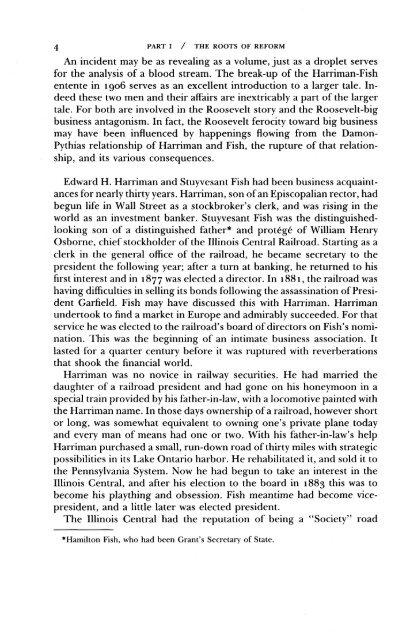Create successful ePaper yourself
Turn your PDF publications into a flip-book with our unique Google optimized e-Paper software.
4 PART I / THE ROOTS OF REFORM<br />
An incident may be as revealing as a volume, just as a droplet serves<br />
for the analysis of a blood stream. The break-up of the Harriman-Fish<br />
entente in 1906 serves as an excellent introduction to a larger tale. Indeed<br />
these two men and their affairs are inextricably a part of the larger<br />
tale. For both are involved in the Roosevelt story and the Roosevelt-big<br />
business antagonism. In fact, the Roosevelt ferocity toward big business<br />
may have been influenced by happenings flowing from the Damon<br />
Pythias relationship of Harriman and Fish, the rupture of that relationship,<br />
and its various consequences.<br />
Edward H. Harriman and Stuyvesant Fish had been business acquaintances<br />
for nearly thirty years. Harriman, son ofan Episcopalian rector, had<br />
begun life in Wall Street as a stockbroker's clerk, and was rising in the<br />
world as an investment banker. Stuyvesant Fish was the distinguishedlooking<br />
son of a distinguished father* and protege of William Henry<br />
Osborne, chief stockholder of the Illinois Central Railroad. Starting as a<br />
clerk in the general office of the railroad, he became secretary to the<br />
president the following year; after a turn at banking, he returned to his<br />
first interest and in 1877 was elected a director. In 1881, the railroad was<br />
having difficulties in selling its bonds following the assassination ofPresident<br />
Garfield. Fish may have discussed this with Harriman. Harriman<br />
undertook to find a market in Europe and admirably succeeded. For that<br />
service he was elected to the railroad's board ofdirectors on Fish's nomination.<br />
This was the beginning of an intimate business association. It<br />
lasted for a quarter century before it was ruptured with reverberations<br />
that shook the financial world.<br />
Harriman was no novice in railway securities. He had married the<br />
daughter of a railroad president and had gone on his honeymoon in a<br />
special train provided by his father-in-law, with a locomotive painted with<br />
the Harriman name. In thosedays ownership ofa railroad, however short<br />
or long, was somewhat equivalent to owning one's private plane today<br />
and every man of means had one or two. With his father-in-Iaw's help<br />
Harriman purchased a small, run-down road ofthirty miles with strategic<br />
possibilities in its Lake Ontario harbor. He rehabilitated it, and sold it to<br />
the Pennsylvania System. Now he had begun to take an interest in the<br />
Illinois Central, and after his election to the board in 1883 this was to<br />
become his plaything and obsession. Fish meantime had become vicepresident,<br />
and a little later was elected president.<br />
The Illinois Central had the reputation of being a "Society" road<br />
*Hamilton Fish, who had been Grant's Secretary of State.

















